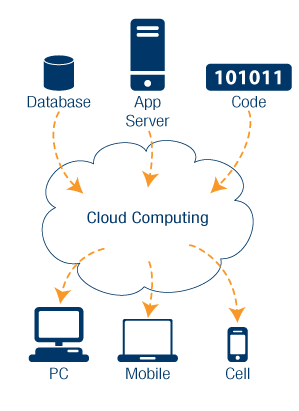Difference between revisions of "Cloud Computing"
| Line 1: | Line 1: | ||
'''Cloud computing''' is the practice of offering shared computational resources to end-users by way of remote servers. Its basic premise includes offering storage, management, and processing of data to an end-user from a centralized location, without the need of powerful individual terminals to carry out computational tasks. Transfer of the processed data files, in the form of documents, emails, or applications can then occurs over a network connection. | '''Cloud computing''' is the practice of offering shared computational resources to end-users by way of remote servers. Its basic premise includes offering storage, management, and processing of data to an end-user from a centralized location, without the need of powerful individual terminals to carry out computational tasks. Transfer of the processed data files, in the form of documents, emails, or applications can then occurs over a network connection. | ||
| − | Access and delivery of data is done through applications such as web browsers, which require far lower computational resources than individual terminals. The dispersal of computational resources from a central location is intended to be more cost-effective than individualized-terminal forms of computing. | + | Access and delivery of data is done through applications such as web browsers, which require far lower computational resources than individual terminals. The dispersal of computational resources from a central location is intended to be more cost-effective than individualized-terminal forms of computing. <ref>[http://dl2af5jf3e.search.serialssolutions.com.proxy.lib.umich.edu/?ctx_ver=Z39.88-2004&ctx_enc=info%3Aofi%2Fenc%3AUTF-8&rfr_id=info:sid/summon.serialssolutions.com&rft_val_fmt=info:ofi/fmt:kev:mtx:journal&rft.genre=article&rft.atitle=Guest+Editors%27+Introduction%3A+In+Cloud+Computing+We+Trust+-+But+Should+We%3F&rft.jtitle=IEEE+Security%26Privacy+Magazine&rft.au=Ghosh%2C+Anup&rft.au=Arce%2C+Ivan&rft.date=2010-01-01&rft.pub=IEEE&rft.issn=1540-7993&rft.volume=8&rft.issue=6&rft.spage=14&rft.epage=16&rft_id=info:doi/10.1109%2FMSP.2010.177&rft.externalDocID=8013 In Cloud Computing We Trust—But Should We?]</ref> |
| Line 35: | Line 35: | ||
There are many ethical concerns with the development of new and revolution technologies such as cloud computing. One of the largest concerns deals with the illegal exchange and sharing of information (see [http://si410ethics11.projects.si.umich.edu/index.php/Digital_Piracy Digital Piracy]) between users on the same cloud interface. This issue is hotly debated and difficult to resolve due to various copyright and licensing regulations. Cloud computing presents users with ethical dilemmas about whether or not to illegal gain access to certain materials whether it be media files, movies, or software. | There are many ethical concerns with the development of new and revolution technologies such as cloud computing. One of the largest concerns deals with the illegal exchange and sharing of information (see [http://si410ethics11.projects.si.umich.edu/index.php/Digital_Piracy Digital Piracy]) between users on the same cloud interface. This issue is hotly debated and difficult to resolve due to various copyright and licensing regulations. Cloud computing presents users with ethical dilemmas about whether or not to illegal gain access to certain materials whether it be media files, movies, or software. | ||
| − | == | + | == References == |
| + | <references/> | ||
Revision as of 20:15, 30 October 2011
Cloud computing is the practice of offering shared computational resources to end-users by way of remote servers. Its basic premise includes offering storage, management, and processing of data to an end-user from a centralized location, without the need of powerful individual terminals to carry out computational tasks. Transfer of the processed data files, in the form of documents, emails, or applications can then occurs over a network connection.
Access and delivery of data is done through applications such as web browsers, which require far lower computational resources than individual terminals. The dispersal of computational resources from a central location is intended to be more cost-effective than individualized-terminal forms of computing. [1]
Contents
What is Cloud Computing
Intro
When companies hire new employees they must install various software packages onto their computers. This usually is a long and tiresome process because many of these packages require certain product licensing numbers. However with cloud computing they can establish an internal network where they can simply access these required programs with ease because they are stored online in the cloud network. This is quicker and easier than manually downloading them onto each specific computer.
Characteristics
Flexible
This users and/or companies can determine how much space they want to store on their network. The amount of space consumed ranges on the user’s needs.
User Friendly
Users can oversee services and have them automatically updated to accommodate their storage, processing, and software needs.
Reasonable
Users are only billed for the resources they use such as space consumed and processing capability.
Dynamics
Benefits
Convenience
Apple recently announced that as of October 12, 2011 that their iCloud will be available to users thus making it easier to manage data across a variety of their products such as the iPod, iPhone, and iPad. When a change is made on one of these devices it is automatically made on the others as well. Cloud services provide these conveniences for users.
Ethical Implications
There are many ethical concerns with the development of new and revolution technologies such as cloud computing. One of the largest concerns deals with the illegal exchange and sharing of information (see Digital Piracy) between users on the same cloud interface. This issue is hotly debated and difficult to resolve due to various copyright and licensing regulations. Cloud computing presents users with ethical dilemmas about whether or not to illegal gain access to certain materials whether it be media files, movies, or software.
